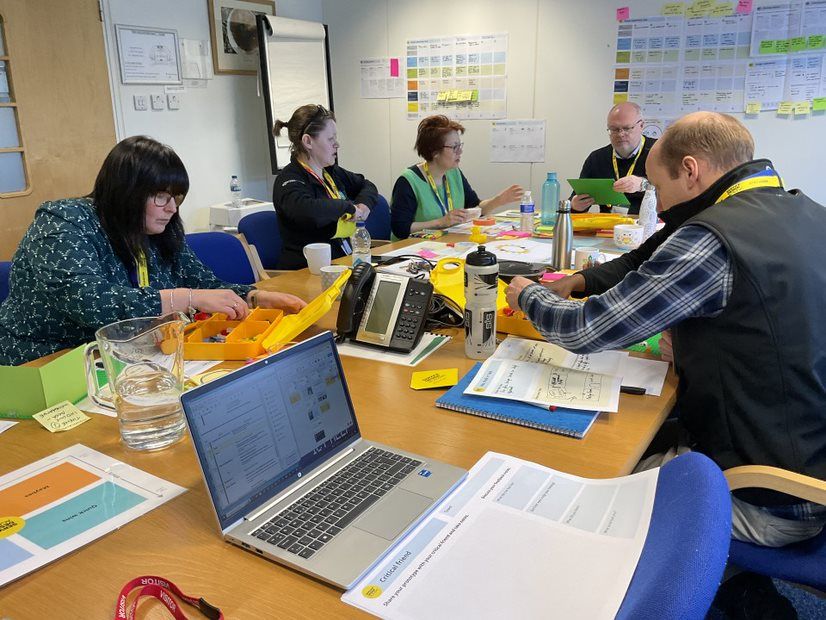
Dr Jo McNicoll tells us what first drew her to the Service Design Academy and how service design has inspired her.
She offers expert advice on how to get the most from the Professional Development Award in Service Design.
My journey with Service Design Academy
I’ve been in the core team for the Professional Development Award since we started designing the accredited six-month course in 2018.
I brought academic and practical design experience to the Service Design Academy, having worked with V&A Dundee as the Design for Business Research Manager and teaching design at Duncan of Jordanstone College of Art and Dundee & Angus College.
My career with the Service Design Academy was sparked initially from my curiosity.
I came along to some introductory taster events and quickly realised that I wanted to work there. I loved the warm atmosphere and quirky sense of fun – it felt like a special place to work and support learners. When an opportunity came to join as a training consultant, I jumped at the chance to come onboard!
Just like service design itself, people are what makes the Service Design Academy.
The team brings different experience and specialisms so that our courses meet learners needs. We also have to be organised, knowledgeable and adaptable to streamline ways of working together, so our learners have the best possible experiences.
Helsinki Inspires
Not long into my new job, I had a really eye-opening experience on how service design makes change for good.
I joined a week’s mission to Helsinki and learned how design is engrained there from the grassroots up. Design is a way thinking from creating aesthetically appealing environments to the practical development of services.
In Helsinki, participatory budgeting is the norm for citizens, who have a genuine say in how services are delivered.
Service design is in their DNA, embedded across local public services and public bodies. Seeing this in action has been a driver for me to build design skills and knowledge with others.

Professional Development Award in Service Design
I helped to develop our very first Professional Development Award and started delivery in 2018. I’ve seen it grow in popularity not only in the UK but across the world.
With the move from face-to-face delivery to online, I’ve seen how effectively collaboration can work using digital tools. This shift doesn’t mean a move from our values – we always make sure our learners are supported fully.
I think the secret of our success is the support we offer – it’s so important to me to demystify and uncomplicate.
I meet with learners before they start the course. It always interests me on why they want to build skills in service design practice. Some people want to learn how to do their jobs better, others want to get the accreditation, and some see it as a stepping-stone to grow their confidence and skills to do new jobs.
I speak to people who have been given a service design remit but want to understand what that means.
Others see our PDA as continuing personal development opportunity to solve problems, innovate and transform – these are the revolutionaries in the workplace!

My PDA advice
There are challenges to balancing work and other commitments when you take on study.
The assessments need proper time and attention to complete. You’ll need to set up workshops and encourage others to give their time to attend and participate.
With 5 weeks to every unit, time is precious.
My advice is to be organised from the very beginning, think ahead to plan events, and get dates in your colleagues’ calendars. We’ll support you with choosing a project of the right scale and scope to make sure that you don’t bite off more than you can chew.

I’m constantly reminding learners that nothing needs to be perfect.
If your projects don’t go to plan that’s perfectly ok. Its reflecting on what happened and demonstrating your learning that matters. We offer coffee shops at the start of each of the 4 units where we will go over what’s expected and in 121 chats we’ll coach you on mapping out plans.
You’re never on your own in the PDA,
You have a fellow buddy on each unit and can keep in touch with a group of peers who will support you with feedback and advice.

Your reward from your hard work will be a portfolio which demonstrates that you can work through a design process using tools and methods in the right way.
You’ll understand how to adapt your learning to meet your needs. Your portfolio is something that you can use to showcase in your organisation to build conversations to support change, or even use to demonstrate your practical skill and experience in job interviews.
The impact that the course brings to learners is nothing less than amazing.
Most are apprehensive to start, but their confidence builds as they appreciate the possibilities that service design brings. They can make a difference, improving services, communities and transforming the way they work. Every time I see this happening, I’m reminded of what a rewarding job I have.
If what Jo has described make you curious to learn more, our next online Professional Development Award starts in August.



